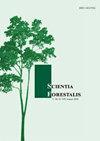Manejo de mudas de Teca e prospecção fitoquímica para avaliação do potencial indicador de pH
IF 0.4
4区 农林科学
Q4 FORESTRY
引用次数: 0
Abstract
Tectona grandis L.f. has an extensive history of logging exploitation in Brazil but also presents a high potential for non-woody product use, when extracting diverse metabolic compounds from the plant. These compounds can be used as pH indicators when properly handled. The aim of this study was to manage Tectona grandis seedlings at different ages to produce a natural pH indicator. For preparing the pH indicator the following steps were taken: 1) Identification and determination of seedling extracts of Tectona grandis L.f. for application as acid-base indicator; 2) evaluation of plant age and extraction method on the acid-base indicator potential; 3) loss of the extracts acid-base indicator potential; and finally 4) use of the extract as pH indicator. All extracts from the seedlings’ vegetative parts changed color when exposed to acidic and basic solutions. However, leaves proved to be the best part for extraction. When the age and methods of obtaining the compound were evaluated, 120-days-old seedlings extracted with a solution of 96ºGL ethyl alcohol and water at 100ºC were found to be the most efficient. However, alcohol extraction reduced the loss of acid-base indicator potential. The best extract obtained by all factors analyzed in this study can be used as a substitute for the commercial indicator phenolphthalein. The alcoholic extract obtained from leaves of 120-days-old Tectona grandis seedlings can be used as pH indicator mostly for more alkaline substances (pH 9 - 14).柚木幼苗的管理和潜在pH指示剂评价的植物化学勘探
在巴西有广泛的伐木开采历史,但当从植物中提取多种代谢化合物时,也呈现出非木本产品使用的高潜力。当处理得当时,这些化合物可以用作pH指标。本研究的目的是对不同年龄的大构造苗进行管理,以产生天然的pH指示剂。pH指示剂的制备步骤如下:1)鉴定测定大地构造草幼苗提取物的酸碱指示剂;2)评价植物年龄和提取方法对酸碱指示剂电位的影响;3)提取物酸碱指示剂电位损失;最后4)提取液作为pH指示剂。幼苗营养部分的提取物在酸性和碱性溶液中都发生了颜色变化。然而,叶子被证明是提取的最佳部分。当评估年龄和获得化合物的方法时,用96ºGL乙醇和水在100ºC的溶液提取120天的幼苗是最有效的。醇提可降低酸碱指示电位的损失。本研究分析的各因素得到的最佳提取物可作为商业指示剂酚酞的替代品。从120 d的大构造木幼苗叶片中提取的酒精提取物可作为pH指示剂,主要用于碱性物质较多(pH为9 ~ 14)。
本文章由计算机程序翻译,如有差异,请以英文原文为准。
求助全文
约1分钟内获得全文
求助全文
来源期刊

Scientia Forestalis
Agricultural and Biological Sciences-Forestry
CiteScore
1.00
自引率
0.00%
发文量
39
期刊介绍:
Scientia Forestalis is a scientific publication of the IPEF – Institute of Forest Research and Studies, founded in 1968, as a nonprofit institution, in agreement with the LCF – Department of Forest Sciences of the ESALQ – Luiz de Queiroz College of Agriculture of the USP – São Paulo University. Scientia Forestalis, affiliated to the ABEC – Brazilian Association of Scientific Publishers, publishes four issues per year of original papers related to the several fields of the Forest Sciences.
The Editorial Board is composed by the Editor, the Scientific Editors (evaluating the manuscript), and the Associated Editors (helping on the decision of acceptation or not of the manuscript, analyzed by the Peer-Reviewers.
 求助内容:
求助内容: 应助结果提醒方式:
应助结果提醒方式:


